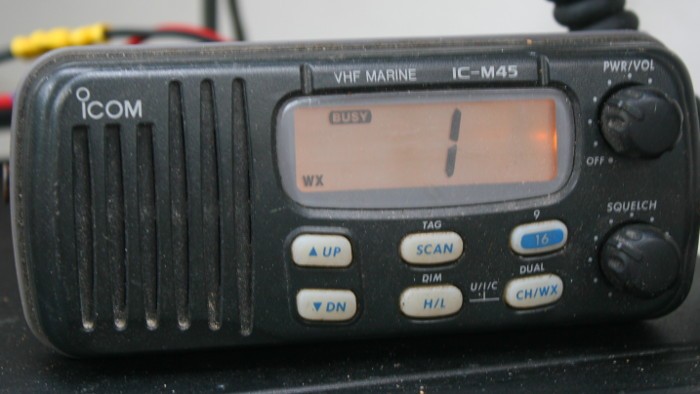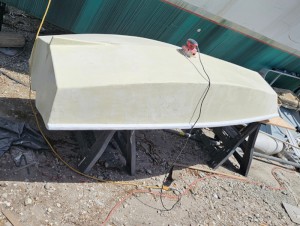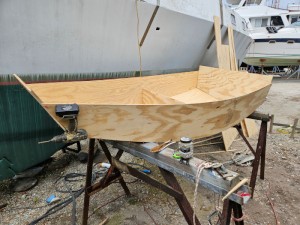Kaimusailing
s/v Kaimu Wharram Catamaran
| Vessel Name: | Kaimu |
| Vessel Make/Model: | Wharram Custom |
| Hailing Port: | Norwalk, CT |
| Crew: | Andy and the Kaimu Crew |
| About: | Sailors in the Baltimore, Annapolis, DC area. |
17 April 2024 | St Marys, GA
Dinghy Skeg
I was suffering with what seemed like a cold and also had allergy symptoms. I awoke and felt fine. The green pollen that was coating everything was gone. Maybe it will return.
07 April 2024 | St. Marys, GA
Clammy Hands
Items came in from TEMU, the Chinese cut rate retailer. One was a nice little drone that cost about twelve and a half dollars. It looked like an easy thing to play with while I coughed and sneezed. I was fighting a summer cold, even though it is not summer elsewhere, it seems like it here. A nice [...]
02 April 2024 | St. Marys, GA
Sun Doggie
After laminating the cedar strips onto the gunwales of the dinghy I found the screws I used wouldn’t come out. The epoxy had seized them. The screw heads were stripped so I cut a straight slot in the heads with the cut off wheel. The cedar smoked when the screw heads got red hot. I could remove [...]
21 March 2024 | St. Marys, GA
Just Add Water
The rainy weekend started off with overcast and fog but no rain. It looked like I might be able to get something done on the D4 dinghy. I wanted to change the bow seat which is really the bow deck. The sailing option uses the deck to hold the freestanding mast. I didn’t like how the deck looked, [...]
01 March 2024 | St. Marys, GA
D4 Dinghy Alternative Seats
The rain event was more wind than rain, strong winds with gusts up to 44 mph. We drove into town to see what the harbor was like. There was a small sailboat that had dragged anchor and was sitting close to shore. The tide was out. We left and played with Bleu at Notter’s Pond.
23 February 2024 | St. Marys, GA
D4 Inside Seams
Day two of the dinghy build started out with me finishing wiring the hull bottoms together on the centerline of the bottom panels. This was much easier than the wiring of the chine edges of the bottom panels and the side panels.
IC-M45

.
The work on the Yamaha engine was done under the boat with the crossdeck shading. I still had to take a break when the salty sweat began burning my eyes. Now, today, I was up on deck after an impressive thunderstorm, the air was comparatively cool. I had to finish bolting the windlass to its mount and find out why its large electric cables couldn’t turn the windlass, yet a small brick battery and some clip leads were able to power the motor. It’s amazing that the motor still works, it looks like a relic from WW1. British, cobby, and all that.
.
My training in troubleshooting electrical circuits dictated the divide and conquer routine. Divide the circuit in half and analyze each half. Then divide the problem half in half, and so on. I tried to measure the resistance of the cabling, since I knew I could measure 12 volts at the windlass end, there must be a resistance preventing current flow, thus the windlass got no power. Strangely the cables were fine, very little resistance, even though they had some salty corrosion on some of the lugs. These are #2 wire which is the size used on a 60 foot boat. My Simpson-Lawrence windlass manual says I could use smaller #4 cable and be OK.
.
I made up a new piece of #10 wire to extend my meters test leads so that I could measure the full length from the battery near the stern to the windlass near the bow. First I substituted the new wire for the ground side of the circuit and the windlass didn’t work. That meant the ground side probably wasn’t the problem. A quick test using the small brick battery and thin test clip leads proved the windlass was working. Now I moved the new wire over to the +12 volt side. I chose to mount it on the outgoing side of the windlass circuit breaker which is located about 1 foot from the battery. The windlass still didn’t work. Now that leaves just a short jumper to the circuit breaker and the circuit breaker itself as the culprits. I used automotive jumper cables to jumper from the battery’s positive terminal to the outgoing terminal of the breaker, I was bypassing the breaker and its battery connection. The windlass ran. Next I jumpered from the ingoing terminal on the breaker to the outgoing terminal, bypassing the breaker. The windlass ran, but then stopped.
.
I was pretty sure the problem was the circuit breaker. When I tried to remove it from its mounting, the stud on the incoming side wouldn’t unthread its nut. I removed the breaker and its input cable. I was able to remove the nut from the stud after wirebrushing the end of the stud. The stud was stripped in its middle, so it was impossible to fully tighten the lug on the input side, thus there was no continuity, no juice for the windlass. The breaker itself was probably fine, just a bad stud, but you can’t fix that, time to buy a new breaker.
.
Now the problem is where can I get a Simpson-Lawrence circuit breaker which is no longer made, they were taken over by Lewmar, and Lewmar dumped those vertical windlasses, very bad design. In the owner's manual the model number of the breaker is shown clearly, but it doesn’t come up on Google. I could just get a breaker of the correct amperage, but what is the correct amperage. The model 1000, someone told me, had a thousand watt motor, that’s why it’s called the 1000. Wrong. The manual says it’s a 400 watt motor. Load amperage is 60. But calculating 400 watts at 12 volts give a much lower amperage. The model number of the breaker has “70“ at the end. It would make sense that a 60 amp windlass, and 60 is higher than what 400 watts would require, might use a 70 amp breaker, so I ordered one from Defender, with shipping, 50 bucks.
.
I would have also ordered a contactor, this is a relay that makes contact when energized from a control, like a foot switch, or the toggle switch in the pilothouse, and can flip from one polarity to the opposite, so the windlass will wind up on one polarity, wind down on the other, and do nothing if not energized. I tested the contactor with an ohm meter while energizing it from the little brick battery. It seemed to work fine.
.
This windlass and its assorted controls are a prime factor in what did me and Kaimu in on that last voyage. The night before at about 2300 hours the windlass suddenly on its own hauled up the anchor while I was in Georgetown, SC. I had to reanchor and thought I had successfully stopped the windlass, but it had only tripped its breaker and then stopped. One of the controls had shorted out and energized the windlass. This resulted in a continual drain on the engine battery, which powers the windlass and its controls. The navigation lights and of course starting the engine take their power from the engine battery, so after a while we had nothing there, not even compass lights.
.
It is now about 2 1/2 weeks till launch date, even though we will launch about a week later. Getting the windlass sorted out is a priority, getting the engine ready for a test run in a 55 gallon drum, and getting the pilothouse set up for voyaging, these are priorities.
.
The usual course of action is fueled by anxiety which increases as the launch day approaches. A lot gets done in the final few hours that couldn't get done in the months before. And, usually, there are a few items that are left over, after the boat launches.
.
I wanted to get the radios completed in the pilothouse. It was a mess in there, even though I had cleared out most of the tool boxes and debris. The whole starboard hull is foul with soot from a tiki torch that was supposed to drive away mosquitoes. Read the fine print captain, not for indoor use. It deposited soot all over the interior. I had to clean the pilothouse before I could mount the radios and the ICOM autotuner. I used Awesome cleaner from the dollar store. Spray it on full strength, wait a few, then sponge it off. Now the pilothouse looks brand new, at least in those parts where radios are going to be installed. The autotuner was mounted over the helm, forward right, screwed to the overhead. The HF antenna wire could be cut a lot shorter. It goes out through the conduit in the overhead for the solar panel cables. It has a coaxial cable and a control cable from the radio, so they were led down between the forward portlights, then to the left to the radio. The KISS ground wire was run up to the autotuner, not much extra cable there, but all the cables are secure. I decided to use the ICOM IC-45 VHF radio that I had bought for Trillium. It’s a simple radio, no DSC, no need for GPS hook up, I attached the RG-213 that extended the mast’s antenna wire and ran a hot and ground from the DC panel. I didn’t have any nice inline fuses, so I put it on a circuit breaker. When I turned it on it was giving NOAA weather and the whip antenna hasn’t yet been installed! I also heard someone calling a bridge to open on channel 16. He should not have used that channel, but I shouldn’t have been able to pick up his transmission.
.
A thunderstorm came through and I was listening how the VHF radio handled the static of the lightning strikes. Then there was a KABOOM and a simultaneous flash of light. The radio was OK, my LED lights were OK, but the fridge which was on shore power had no power. I confirmed that there was no internet signal. There was a cell tower signal. I suspect the lightning hit the power lines on the North River Causeway, about a half mile away. Pfft, no power.
.
The image is of our IC-M45 radio. It is on channel 1, the local weather.






